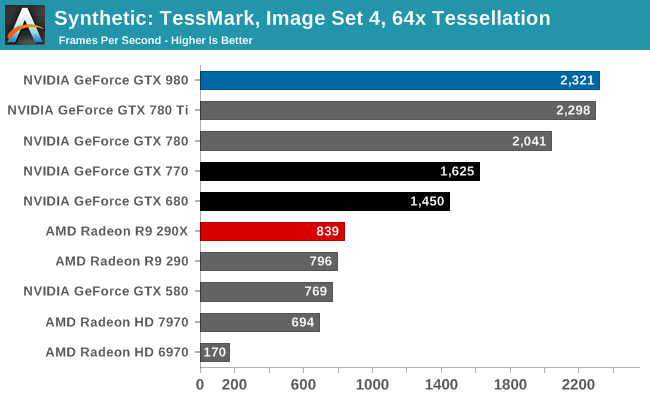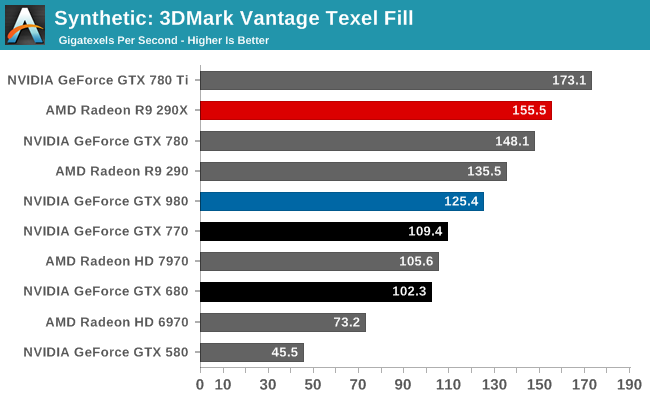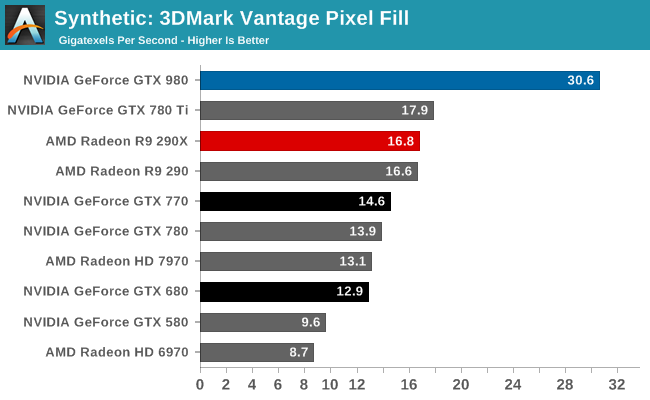The NVIDIA GeForce GTX 980 Review: Maxwell Mark 2
by Ryan Smith on September 18, 2014 10:30 PM ESTSynthetics
As always we’ll also take a quick look at synthetic performance. These tests mainly serve as a canary for finding important architectural changes, and with the exception of pixel throughput we are not expecting any major changes for GTX 980 and GM204.

GM204 is designed to have an ever-so-slightly higher triangle throughput rate than GK110 – 16 tris/clock versus 15 tris/clock, and sure enough the GTX 980 comes out on top in TessMark, slightly edging out the GTX 780 Ti. The difference is only very slight here, and though GM204 should be a bit more powerful than GK110 in practice it’s a dead heat.
Moving on, we have our 3DMark Vantage texture and pixel fillrate tests, which present our cards with massive amounts of texturing and color blending work. These aren’t results we suggest comparing across different vendors, but they’re good for tracking improvements and changes within a single product family.

Beginning with Maxwell NVIDIA reduced their texture-to-compute ratio from 12:1 to 16:1. As a result of this change Maxwell GPUs have fewer texture units than comparable Kepler GPUs. Compounding this effect is the fact that Maxwell CUDA cores are more efficient than Kepler CUDA cores, leading to NVIDIA placing fewer cores overall and further reducing the texture fill rate.
As a result the GTX 980 is not texture fillrate competitive with any of the GK110 cards. It is competitive with the GK104 cards, but only because these cards had the same number of texture units at 128. NVIDIA has told us that they believe this new ratio is a better fit for modern workloads, and judging from the performance we’re seeing elsewhere it would appear that NVIDIA is right.

On the other hand, thanks to NVIDIA’s newer 3rd generation delta color compression technology, our 3DMark pixel fillrate performance is through the roof. GTX 980 comes very close to doubling the throughput of our GK110 cards and more than doubles the throughput of the GK104 cards, reflecting the fact that it has 64 ROPs and more importantly has the available bandwidth to put them to good use.
This benchmark in a nutshell is why NVIDIA can deliver chart-topping performance despite having only 2/3rds the memory bandwidth of GTX 780 Ti. By improving their color compression to this point, NVIDIA can significantly reduce their memory bandwidth requirements Maxwell 2, allowing them to do more with less. In real games the result won’t be anywhere near this remarkable since this is a pure pixel fillrate test, but it goes to show that NVIDIA has been able to expand their effective memory bandwidth in concert with their ROP and shader performance improvements.










274 Comments
View All Comments
Nfarce - Friday, September 19, 2014 - link
Well that settles it then. I'll take two 870s for SLI (Guru3D has benches for it). Now the question remains what the vendors will actually sell them for and what the various versions will go for (factory overclocked, etc.). On top of the question of how hot an item these cards will be. I remember trying to get a 680 for nearly two weeks from the Egg just hitting page refresh randomly and hoping to catch a moment they were back in stock.HaB1971 - Friday, September 19, 2014 - link
Newegg has the 970 for $339 on the front page of the Desktop video cards page... you can't search for them though oddly enoughInfy2 - Friday, September 19, 2014 - link
GTX 980 leaves TDP room for even faster card targeting 250W and beyond, but will there be one coming?Mr Perfect - Friday, September 19, 2014 - link
Seeing as this is only a GM204 part, it's probably safe to say there will be a GM210 part in the higher wattage ranges. Probably some damn fool $1000 Titan card...Laststop311 - Friday, September 19, 2014 - link
probably will see it as the titan 2 at 1000 first then a cheaper non titan version just like they did with gk110. Not until 20nm is sorted out thoevilspoons - Friday, September 19, 2014 - link
So basically the 980 is my 680 SLI setup, but on a single card, plus some new features. And it's quieter and uses less power... And then you can SLI it later. Awesome!!Nfarce - Friday, September 19, 2014 - link
Yup! Just like my original single 680 was equal to two 570s. This wait was worth skipping the 7-series over. I have a feeling there are going to be a whole lot of 670s and 680s flooding the used market starting Friday.lilmoe - Friday, September 19, 2014 - link
TSMC 28nm is showing its age...CristianMataoanu - Friday, September 19, 2014 - link
I see the 980 is rated at 165W while the 680 is rated at 195W, But in the test results show that the total system consumption using the 980 is 8W higher than the one using the 680. I understand there may be some variantion of the cpu power because the 980 pushes more fps and therefore there is more work for the cpu.Is it posible that the 680 is less efficient in using its resources and therefore not being able to hit max tdp?
jay401 - Friday, September 19, 2014 - link
On the Power, Temp, and Noise page, the chart labeled "GeForce GTX 980 Average Clockspeeds" shows a label reading "Battlefield 3" instead of "Battlefield 4". =)